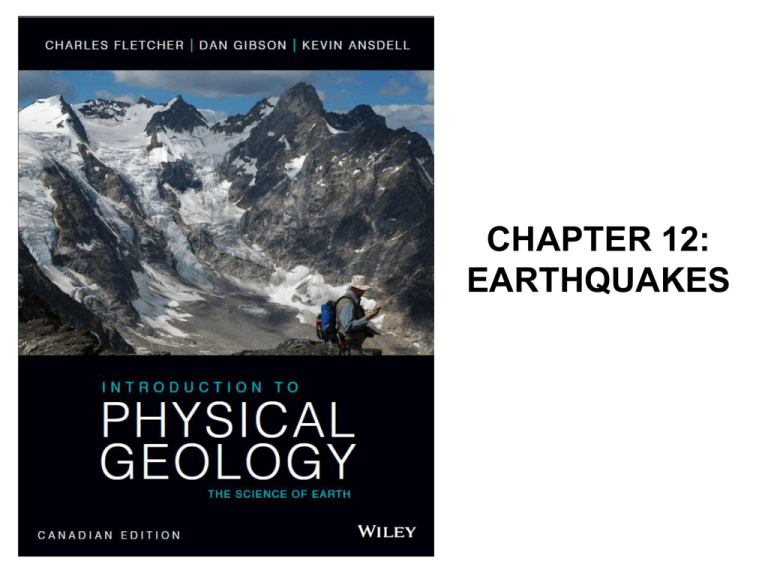
CHAPTER 12:
EARTHQUAKES
Earthquakes
• An Earthquake is a sudden shaking of the crust
What causes earthquakes?
• Most earthquakes are associated
with the breakage and
displacement of rocks, often along
a known fault
• Kinetic energy is released as seismic
waves
• Seismic waves radiate through the
Earth's interior resulting in
"shaking“ at surface
More than 380 major cities lie on or near
unstable regions of the Earth’s crust
(potential for casualties and infrastructure damage is high)
How do earthquake locations relate to plate boundaries? Identify some
of the plates on this map.
There Are Several Types of Earthquake
Hazards
• Ground shaking produces sediment liquefaction (instability of the ground),
mass wasting (landslides), and damage to buildings and other structures
• Fires following an earthquake can be catastrophic and fire-fighting capabilities
may be compromised
• Often water lines and emergency equipment are damaged and utility and
communications systems are disrupted
• A tsunami may be generated
Tsunami
Simulation
Animation
Kashmir, 2005
Explain how an earthquake could lead to flooding.
Natural Resources Canada map of seismic
shaking hazards
What is the
relative
earthquake
risk in your
part of the
country?
The Elastic Rebound Theory
• The elastic rebound theory explains the origin of earthquakes
• Energy is stored in the form of elastically deformed rock. When the strain
exceeds the strength of the rock it breaks the energy is released.
Strain Release
• Eventually the rock is no longer able to accommodate the buildup of strain and it
ruptures, either along a pre-existing fault or at a new location.
Is this a
normal or a
reverse fault?
What are the definitions of “focus” and “epicenter”?
Clusters
• Earthquakes tend to occur in
clusters, both in time and in space.
Intraplate Earthquakes
• Most seismicity occurs at plate boundaries,but intraplate earthquakes are also
common
Identify some intraplate earthquakes on this map.
Divergent, convergent, and transform margins
• Divergent, convergent, and transform margins are the sites of frequent earthquake
activity
Divergent margin
Intraplate location
Convergent margin
Transform margin
Identify some
divergent, convergent
and transform
boundaries on this
map where there
have been
earthquakes.
Intraplate Earthquakes
• Poorly understood
• Most have shallow foci
• Tend to occur in soft, weak areas of plate interiors, caused by stresses
transmitted from plate boundaries,
• Reactivation of old rift zones or faults (e.g., Logan Fault)
• Hot Spots
– Yellowstone
– Hawaii
Divergent Seismicity
Convergent Seismicity
• The zone of seismicity along the plane of the subducting plate is called the
Wadati-Benioff Zone
Where can you
see some
Wadati-Benioff
zones on this
map?
Which plates
are involved?
Transform Seismicity
What are some features that the San Andreas and
North Anatolian Faults have in common?
Earthquakes produce four types of seismic
waves
• Two types of Body
Waves and two types of
Surface Waves
Body waves (within the crust)
Surface waves
Liquids do not resist changes in shape - they absorb S WAVES
rather than transmit them.
A Seismogram is produced by a Seismometer
Seismometers
• Seismometers are instruments that measure and help locate earthquakes
• An earthquake near Vancouver is measured by a seismometer in Saskatoon
Seismometers in Iqaluit, Halifax and St. John’s are
used to locate an earthquake in central Quebec
Could an
earthquake be
located with just
two seismic
stations?
In fact, many seismometers are used to
locate earthquakes.
Expressing Earthquake Magnitude
• Earthquake magnitude is expressed as a whole number and a decimal fraction (e.g.,
7.3)
Modified Mercalli (MM) intensity scale
• Intensity is expressed using the Modified Mercalli (MM) intensity scale
What is the difference between earthquake magnitude and intensity?
Magnitude of an earthquake using the Richter
method
Comparison of energy released and damage
done by different events
Seismology
• Seismology is the study of seismic waves in order to improve our
understanding of the Earth’s interior
• Wave refraction is used to identify a discontinuity
P-wave and S-wave shadow zones
Why are S waves
not transmitted
through the
Earth’s core?
Seismic Data
• Seismic data confirm the existence of discontinuities
in Earth’s interior
Mohorovicic Discontinuity
•
•
~ 8 km beneath oceanic basins
~ 20 to ~70 km beneath continents
This map shows just a
small fraction of all of
the seismometers on
Earth.
Seismic Tomography
• Seismic tomography uses seismic data from hundreds of seismic stations and
hundreds of different earthquakes to provide a 3-dimensional seismic velocity
image of the Earth’s interior.
Modeling with Tomographic Images
Why is the subducted Farallon Plate in the mantle
beneath North America represented by a zone of
higher seismic velocity than the surrounding mantle?
COPYRIGHT
Copyright © 2014 John Wiley & Sons Canada, Ltd. All
rights reserved. Reproduction or translation of this work
beyond that permitted by Access Copyright (The Canadian
Copyright Licensing Agency) is unlawful. Requests for
further information should be addressed to the
Permissions Department, John Wiley & Sons Canada, Ltd.
The purchaser may make back-up copies for his or her
own use only and not for distribution or resale. The
author and the publisher assume no responsibility for
errors, omissions, or damages caused by the use of these
programs or from the use of the information contained
herein.









